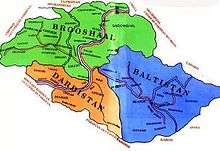Dardistan
| Dardistan | |
|---|---|
| Region | |
| Country | Pakistan, India, Afghanistan |
| Area | |
| • Total | 87,821 km2 (33,908 sq mi) |
| Population (2009) | |
| • Total | 658,164 |
| • Density | 7.5/km2 (19/sq mi) |
| Time zone | UTC+5:30 (UTC) |
| Website | dardistantimes.com |
Dardistan is a term coined by Gottlieb William Leitner for northern Pakistan, Kashmir and parts of north-eastern Afghanistan. It is inhabited by Dards speaking Dardic languages.[1] It includes Chitral, the upper reaches of the Panjkora River, the Kohistan (highland) of Swat, and the upper portions of the Gilgit Agency. Mentioned by the classical historians Pliny the Elder, Ptolemy, and Herodotus, the Dards (Daradae, Daradrae, or Derdae) are said to be people of Aryan origin who ascended the Indus Valley from the Punjab plains, reaching as far north as Chitral. They were converted to Islam in the 14th century and speak three distinct dialects of Gilgit, Khowar, Burushaski, and Shina, employing the Persian script in writing.
Historical origin
Herodotus (III. 102-105) is the first author who refers to the country of Dards, placing it between Kashmir and Afghanistan. It is also referenced in Mahabharata, where it mentions the tribute of the ant-gold pipilika brought by the nations of the north to one of the sons of Pandu, king Yudhishthira.The region was ruled by the king Lalitaditya during 8th century.
The Dards are also the Darada of the Sanskrit writers. The Darada and Himavanta were the regions to which Buddha sent his missionaries.
History
During the 13th century Lankar Chak also known as Shankar Chak was the ruler of Dardistan and was defeated by his enemies which resulted in him taking refuge with Sahadeva the Raja of Kashmir, thus almost all chaks migrated to kashmir and made it their homeland. Due to the turmoils in Kashmir Lankar Chaks descendents managed to overthrow the Syed dynasty and gave seven rulers to Kashmir for a brief period of 33 years until they were subdued by Moghul emperor Akbar. The Chaks are now considered an ethnic kashmiri tribe of dardic origin. [2] [3][4]
Geography

More than 75% of Dardistan is located in mountainous regions.
Dardic languages
See also
References
- ↑ "A Journey to Kashmir's Gurez Valley".
- ↑ Explore Kashmiri Pandits by Bansi Pandit
- ↑ Kashur The Kashmiri Speaking People By Mohini Qasba Raina
- ↑ Maryam, Moeininia; Hadi, Alemzade (2013-01-01). "THE RISE AND FALL OF THE CHAKS IN KASHMIR (962-993 A.D.)". 9 (17): 135–154.
Further reading

- ALLAN, NIGEL J. R.; EDEL’MAN, D. I. (1994). "DARDESTĀN". Encyclopaedia Iranica, Vol. VII, Fasc. 1. pp. 26–31.